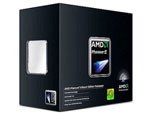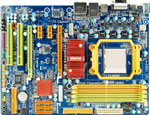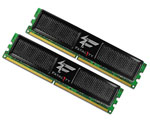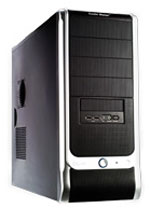AMD Budget
Leaving the entry-level sector behind and with a budget of under $800, our options increase significantly. Our aim here is to provide a configuration that allows for a nice balance of performance at stock speeds. This doesn't mean you have to spend over $800 though, as prices have dropped in the past year and performance for the dollar has definitely increased. Both budget systems are under $800 complete, with the basic box under $500 in both cases. This gives you the option to increase graphics power or go for a larger monitor (or both) and still be less than $1000. The assembled system is balanced for a wide variety of computing tasks, but final tweaks can tilt it toward gaming and graphics for example, if that is what you aim for.
Generally we consider PC Gaming rigs to begin at the next price category (i.e. the low end of midrange), but adding a decent graphics card and a larger monitor will definitely make one of these budget systems a good choice for entry gaming at around $1000. If that is your goal take a look at the Phenom II Guide for help in selecting a graphics card and display for your price point.
| AMD Budget PC | ||
| Hardware | Component | Price |
| Processor | AMD Phenom II X3 720 BE (2.8GHzx3, 3x512KB L2, 6MB L3 Cache) |
$145 |
| Cooling | CPU Retail HSF | $- |
| Video | On-Board | $- |
| Motherboard | Biostar TForce TA790GX3 A2+ | $110 |
| Memory | OCZ Fatal1ty Edition 4GB DDR2-1066 OCZ2F10664GK ($28 after rebate) | $43 |
| Hard Drive | WD Caviar GP WD5000AACS 500GB | $59 |
| Optical Drive | Samsung 22X DVDRW/DL SH-S202G | $25 |
| Audio | On-Board | $- |
| Case | Cooler Master Elite 330 RC-330-KKN1-GP Mid Tower | $40 |
| Power Supply | BFG Tech LS Series LS-550 550W SLI Certified, CrossFire Ready, 80 PLUS Certified ($20 Rebate) | $60 |
| Base System Total | $482 | |
| Display | ViewSonic VX2233wm Black 21.5" 5ms Widescreen 16:9 LCD (1920x1080) | $170 |
| Speakers | Logitech R-20 12 Watts RMS 2.1 Multimedia Speaker | $18 |
| Input | Microsoft CA9-00001 Black PS/2 Standard Keyboard and Optical USB/PS2 Mouse - OEM | $16 |
| Operating System | Microsoft Vista Home Premium OEM | $99 |
| Complete System Bottom Line | $785 | |
 |
While the GPU is the most important factor in game performance, the CPU is also a factor. To make sure the CPU is not a bottleneck now or in the near future should you upgrade your budget PC, a Black Edition Phenom II X3 is the CPU choice. The Phenom II 720 Black Edition has an unlocked multiplier should you choose to overclock, which makes overclocking as simple as it gets. It is rated at 2.8GHz with 3x512KB L2 cache, and 6MB of L3 cache. As a 45nm Phenom II it is also a dynamite overclocker - in fact it is the same CPU we recommended in our Phenom II OC system just a few weeks ago.
 |
We've paired the Phenom II 720 BE with the Biostar TForce TA790GX3 A2+, a perfect match for those looking to squeeze as much performance out of their money as possible. The Biostar is loaded with overclocking features and features integrated AMD HD 3300 graphics with an HDMI/DVI interface and 1080P support. This means very decent performance using the onboard graphics. Biostar offers both AM2+ and AM3 CPU support for processors like the Phenom II 720BE when used with cheaper DDR2 memory. Biostar includes 128MB DDR2 sideport memory for improved GPU performance, Realtek ALC 888 HD Audio codec, Gigabit LAN, 16GB memory support, six 3Gb/s ports capable of RAID 0/1/10/5, 10 USB ports, two PCI-E x16 slots (dual x8 CF), two PCI-E x1 slots, and two PCI slots. The BIOS caters to the casual overclocker and this board performs very well in a variety of tests.
 |
We've chosen OCZ Fatal1ty Edition 4GB DDR2 1066 (PC2 8500) in a 4GB kit for $43. This is a great value in DDR2-1000 memory from a top memory supplier. Right now it's an even better deal with a $15 rebate that lowers your net price to $28. The extra 1066 speed lets you run your memory at a faster speed or provide reserves for overclocking the CPU. OCZ is a great memory choice, but there are many memory options at great prices today. Quality DDR2-800 and DDR2-1000 RAM from Corsair, OCZ, G.Skill, Mushkin, and Geil are available at any of the major online retailers. Just be sure to look for RAM with better timings if you can afford it.
The remaining components are the same as our entry systems. The hard drive remains a 500GB Western Digital. If you'd prefer a longer warranty, look at Seagate, which includes a 5-year warranty on some of their drives for a few dollars more. The DVD burner remains the same Samsung 22X.
 |
The case receives an upgrade with the selection of the Cooler Master Elite 330 and our AnandTech Gold Editors Choice BFG Tech LS Series LS-550 550W power supply. The BFG currently has a $20 rebate which reduces the final cost to $60. The BFG 550W is a great power supply, but you could save a few dollars here with an OCZ, Corsair, or PC Power and Cooling PSU, which are often on rebate in recent months. It all depends on the timing of your system purchase.
 |
The LCD display was an easy choice with the full HD high resolution Viewsonic 22" 16:9 widescreen for just $170. A 21.5" monitor with 1920x1080 resolution with a 3-year warranty from a major monitor maker is certainly a good value. If you prefer a larger screen you can find a 24" widescreen starting at $250, though most are $300 or more. If you need to save a few dollars a lower resolution 19" or 20" would do.
 |
If you want more video power for gaming you can add an ATI HD 4830 for just $75-$90. This will get you into gaming and it is a terrific value at this price according to our Graphics Editor. He recommends the Radeon HD 4850 as the start of true HD gaming starting at just $120 or a Radeon HD 4870 512MB which you can find for as little as $155. Any of the three cards would still keep your total well below $1000. The 4870 addition totals just $940 for an extremely capable 1920x1080 system complete with a Viewsonic 1080P monitor.










66 Comments
View All Comments
scwtlover - Monday, March 16, 2009 - link
Thanks. Do you have an opinion regarding the significance of voltage?Wesley Fink - Monday, March 16, 2009 - link
At the same speed or overclock lower voltages that actually work are always better. Higher voltage allows some incredible performance but high voltages shorten component life. If two memories are honestly rated at the same speed and timings but one is lower voltage at that speed, the low voltage is the better choice.There are fewer variations in memory speed, timings, and voltages than you might imagine, though. Almost every memory vendor buys memory chips on the open market. When one company stumbles onto a terrific new chip or PCB it isn't long until most of the major players have the same thing. Expertise in PCB design and SPD programming can matter in performance, but not nearly as much as the actual memory chip and binning used.
scwtlover - Tuesday, March 17, 2009 - link
I apologize for not asking my question more clearly. I understand your general point regarding lower voltages putting less stress on computer parts. I see, however, that while I can get quality 800 DDR2 RAM at 1.8 volts and CAS 5, to get quality 1066 DDR2 RAM at CAS 5, the RAM spec will be 2.0V or even higher. What considerations come into play in making this choice for an AMD system?erple2 - Tuesday, March 17, 2009 - link
By "incredible performance" do you mean that are visible in benchmarks only, or in real world usage?scwtlover - Monday, March 16, 2009 - link
After reading your praise of ASRock's 780GX board for the AMD entry-level system, I was surprised not to find it even mentioned for the AMD budget system. Currently, it's $5 less expensive than the Biostar board you do recommend. As I try to finalize components for my own new build, should I being drawing adverse conclusions about the ASRock 790GX board?MFK - Monday, March 16, 2009 - link
Whats the deal with those these days?I got a cable box for my cable signals but I need my HTPC to act as a DVR.
I think any HTPC should include a TIVO card. Doesn't have to be a TV tuner though!
What would be the cheapest way to add DVR functionality to the HTPCs in the article?
BernardP - Monday, March 16, 2009 - link
All the suggestions are nice and well-balanced. However, monitor choices on the entry-level systems seem questionable. Yes, you have to meet the price point, but these days, it seems 22-inch monitor have become the minimum worth spending money on. Spending on a brand-new 17-inch or 19-inch monitor seems a waste, unless someone has not enough space to fit a larger monitor.The0ne - Monday, March 16, 2009 - link
I agree. 22" LCDs have the sweet spot now. Even the 24"s are coming down in price.Spivonious - Monday, March 16, 2009 - link
Why no tuner in the HTPC? Also, since the 9400 chipset handles all decoding, why use a beefy processor? Also, a 500W power supply is way overkill. 350W would be plenty and probably quieter too.Save $30 on the CPU and go with the E1400.
Other than that, it looks almost exactly like the HTPC I spec'ed for myself last week, only to find out that my bonus was not very big after Uncle Sam got to it.
7Enigma - Monday, March 16, 2009 - link
Did you read the article? They gave an explaination (whether you agree with it or not):[quote]"Since most end-users are on cable or satellite for TV, we will make no recommendations at all for a TV tuner. Of the many possible uses of an HTPC the great majority of end-users store, play, and stream movies with their HTPC computers. That is mostly what their HTPC systems are used for and that is where we have concentrated our recommendations. In general the processing power in both systems has increased since our December 2009 guide, but costs have gone down a bit."
"As we discussed in the HTPC introduction, we did not include a TV tuner in the configuration since most end-users are now using their cable and satellite feeds. Few users, therefore, have any real need for a TV tuner card." [/quote]
As for the beefy processor I somewhat agree with you. If all you are doing is playing movies and such then a lowly cpu is all that is needed due to the mobo. But any form of heavy processing work such as encoding to highly compressed formats, or multitasking while watching a video and it makes sense. Having the better cpu certainly gives you the flexibility to do more than just watch movies.